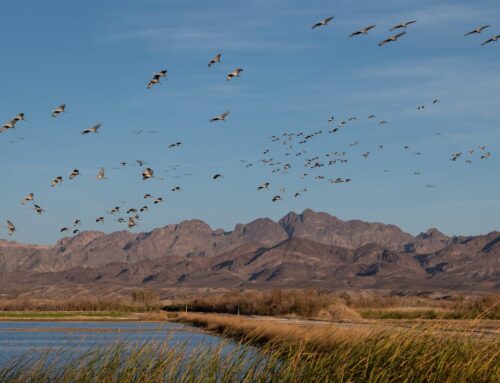Energy reliability takes center stage at Midwest Energy Summit
January 7, 2025
FARGO, N.D. – Energy companies have three priorities when it comes to electricity – make it affordable, clean and reliable. According to North American Electric Reliability Corporation’s (NERC) Camilo Serna, those priorities should work in balance together like three legs on a stool. Serna is the vice president of strategy and external engagement at NERC, which was formally established in 2005 by Congress to ensure a highly reliable and secure bulk power system.
He provided an insight into the state of energy reliability in North America during the Midwest Energy Summit held in Fargo Nov. 7. The Fargo Moorhead West Fargo Chamber hosted the event.

/ Carrie McDermott
“We are there to effectively reduce the risk to the reliability and security of the grid and we do that working with multiple stakeholders, multiple companies,” he told the audience. “We’re an industry-based organization that gets input from all of you to develop the work that we do and how we do it.”
NERC develops and enforces mandatory reliability standards for all the transmission companies, the generation companies that are connected to the bulk power system which is done by working with regional entities, he explained. Those entities help NERC audit the implementation of those standards and ensure that the industry maintains a safe, highly secure, reliable grid.
Two expert panels at the summit discussed the future of traditional fuels and renewables. Paul Jordan, CEO of Corval Group, Inc., moderated the renewables panel, where experts discussed how the sector is navigating rising market demand, workforce shortages, changing state and federal policies and other key indicators shaping the future of energy.
Energy demands are complex and growing, thanks to an increase in data centers, semiconductor manufacturing and expanding populations. The opportunity for renewables in this space is huge, according to Bria Shea, regional vice president of regulatory for the Upper Midwest at Xcel Energy. After no to little load growth for 10 or 15 years, electrification has increased the electric vehicle adoption rates and growing data centers are creating increased power load demands, she shared.
“We’re having conversations now around gigawatts, not megawatts. We’re talking about the opportunity to double or triple the current system,” she said. “One nice thing about data centers is that, by and large, a lot of their goals are in line with the sustainability efforts that a lot of us are working towards so they do want to be as clean as possible. Renewables fit really nicely in there.”
The challenge is that renewables are intermittent and data centers require consistent power, as they run non-stop. Shea said there needs to be other resources to support the renewables so power companies can serve these loads 24-7.
“There are really nice partnerships there. As we think about the need for new technology, another advantage of data centers is that they’ve got the capital to invest. Along with utilities and the industry, now we’ve got these other partners starting to spend significant amounts when looking at new nuclear, long-duration storage hydrogen, those supplemental resources that we need,” she said. “I think in addition to the renewable opportunity the data centers bring is the capital that will help us advance these other resources to support the needs that we see overall including from data centers.”
Danny Martell, vice president of Central Region and Engagement Campaigns with NextEra Energy, a wind- and solar-based power generator out of Florida, said the most deployable, fastest source of power for new builds will continue to be renewable energy.
“You can plug and play, and move quickly and absolutely. It’s not a purely dispatchable source of power but nevertheless, it’s quick and it’s affordable,” he said.
Martell cited a report issued in September 2024 by
McKenzie Consulting
that said in the next seven years, the country will add approximately 470 gigawatts of power, as opposed to the last seven years when about 140 gigawatts were added nationally.
“It has to play a role in terms of how we continue to meet that incredible, mind-blowing demand,” Martell said.
John Hollingsworth, director of renewable projects at Allete Clean Energy, said the busiest years for his company were 2019-2021, when they installed roughly 12-14 gigawatts of wind power. Today, the projected need is 26 or 27 gigawatts.
“The U.S. assembly plants aren’t able to supply all that so you do have to look overseas, unfortunately, for some of this,” he said. “It’s going to be growing at a rapid rate here and how you source products is going to continue to be front of mind for all of us.”
To address the need for a strong workforce to handle the sector’s growth over the next seven years, Xcel is signing labor agreements earlier than ever and mapping out the types of workers needed and what skills they’ll need to possess, Shea said.
“We are definitely being more proactive than we ever have. Labor is part of our project plans like it never has been before,” she said. “In addition to planning and having early conversations we also have a pretty robust training program – apprenticeships where we’re bringing people in so they can do on-the-job training. We’re reaching out to historically underrepresented communities to make sure that everybody has an opportunity here in the energy transition and that we can train you. We will bring you along.”
“It’s difficult to find employees to work, especially in rural communities, who have the skills that can facilitate the necessary demand of operator plants. So if you look in the future, this is only going to grow,” Hollingsworth added.
Another challenge energy leaders cited is navigating different states’ permitting regulations as well as meeting federal regulations.
The Energy Permitting Reform Act of 2024
, introduced over the summer by Sen. Joe Manchin (D-WV) and Sen. John Barrasso (R-WY), is designed to modernize and streamline the permitting process for energy projects across the country. The current process has created a bottleneck for energy projects and infrastructure buildout, experts say, both of which are needed to achieve the energy transition, ensure grid reliability, meet growing energy demands and reduce energy costs.
Counties within a state can often have different regulations, which creates more hurdles for energy projects. Martell said having a predictable state regulatory environment that funnels downward can help move projects forward.
“It demonstrates to the local government that the capital is here, it wants to stay. It wants to build more, so having predictability is the most important thing,” Martell said.
Educating the public can be key to helping energy projects succeed, Shea said.
“We get more advocates, more people who are understanding not only the challenges but the opportunities, the economic opportunities, of the jobs that are here,” she said. “It shows how people can participate. The more people understand what we’re doing, the more people can start to talk about this and help our causes because I do think the stability factor is huge for us.”
“There’s one huge advantage of renewables in that there is no volatility in pricing,” Shea continued. “We’re not buying fuel. So once we’ve got that capital spent, we’ve got operation and maintenance expenses, but we’re not exposed to the market like we are with other fuels. I think it all gets back to diversification.”
Nuclear energy is growing in the U.S. About 20% of the country’s electricity has come from nuclear power since 1990, according to the U.S. Energy Information Administration. As of Aug. 1, 2023, 93 nuclear reactors were in operation at 54 nuclear power plants in 28 states.
Shea said Xcel has three nuclear facilities with a long history of success. The company has also been modeling small modular reactors or SMRs.
“They’ve been a key contributor to our baseload needs as well as our carbon-free goals,” she said of the nuclear facilities. “Our modeling shows SMRs showing up in the late 2030s, early 2040s. Of course, there is a lot of work to do to get there. Sighting is pretty complicated, you need a lot of water, a pretty skilled workforce, and the right infrastructure. ”

/ Carrie McDermott
Traditional fuels such as natural gas, coal and oil have been the country’s backbone for reliable energy production. Brian Kalk, chief research officer with the Energy and Environmental Research Center (EERC) at the University of North Dakota in Grand Forks, served as moderator of the traditional fuels panel. They discussed challenges and opportunities and what lies ahead for the traditional fuels industry.
“As you look at requirements for different types of fuels, that affects the viability of our infrastructure and the use of our infrastructure,” said Danette Welsh, director of government relations with ONEOK, Inc. The company delivers energy products such as natural gas liquids, refined products and crude oil through a more than 50,000-mile pipeline network.
“Say you put a product, a diesel product, into the line in Houston and the demand for that product is in Fargo. It’s much like banking where if you have a kid in college five states away and they need money, you put money into their account and they can take it out. It’s not the same dollar bill, but it’s still constructed the same way, it’s still used the same way. That’s very much the way that our system works,” she said.
Varying fuel delivery requirements across different regions can reduce infrastructure efficiency and increase service costs. When state governments impose different fuel mandates, it disrupts the cost-effectiveness of the system, Welsh explained, even if there isn’t strong consumer demand for those specific fuels, ultimately raising costs for consumers.
Karl Fennessey, vice president of corporate public policy with ConocoPhillips, said fiscal and regulatory stability are key, along with securing energy stability. The company’s priorities are focused around taxes and regulatory reform, he said.
“You don’t need to take a sledgehammer to everything that was done, but let’s be smart about it. Let’s look at what works, what doesn’t work and let’s use that scalpel to clean things up or to make them so they actually do work so the results you want are achievable in a cost-effective manner,” Fennessey said.
“What happens in North Dakota matters around the world. Not only does it bring low-cost secure energy to the U.S. for all of us, but it also allows the U.S. to project power and to support its allies overseas through exports,” Fennessey continued.

/ Carrie McDermott
Todd Sailer, vice president of power supply with Minnkota Power Cooperative headquartered in Grand Forks, said North Dakota has some big advantages – its workforce, mineral resources and a stable fiscal and regulatory environment.
“North Dakota is very fortunate to have amazing minerals. We’re still early on in what North Dakota can do to supply low-cost, low-emission barrels for the U.S. and around the globe. So what does that allow us to do as a country? It allows the country to not only insulate itself from the shocks and some of the conflict that’s going on currently in the Middle East but allows you to help your trading partners,” Sailer said.
In wrapping up the discussion, the experts agreed that to increase the reliability of the nation’s power grid, more transmission is needed and each type of fuel source has its own unique set of challenges.
“Traditional fuels are challenged by carbon management, by what our emissions are and how we manage that piece of our product. Renewables are challenged by reliability and nuclear has the challenge of maybe consumer confidence and cost,” Welsh said. “Thinking about the growth of the energy demand domestically, you can’t meet that with any one sector. We need all of those sectors to be able to meet demands.”
Search
RECENT PRESS RELEASES
Related Post




